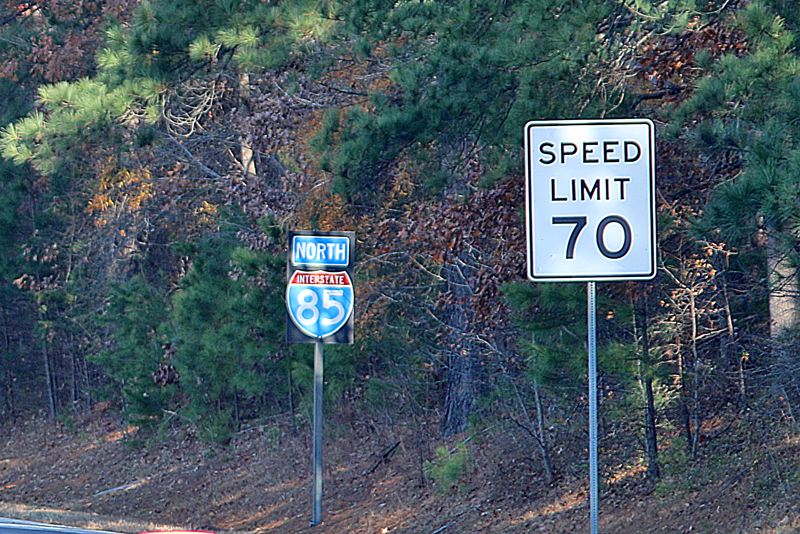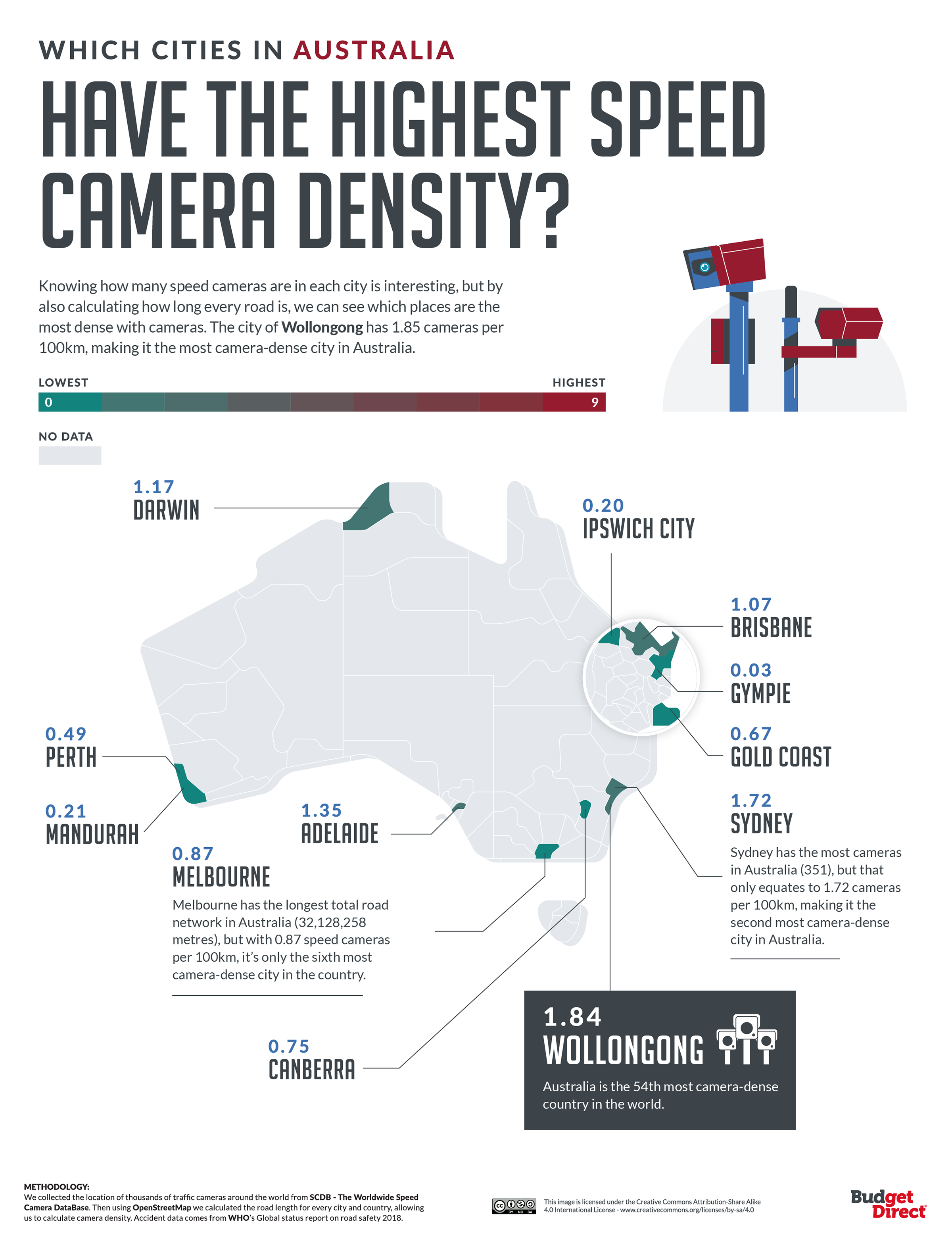Cameras which record your speed seem to be taking over the world, patrolling the highways 24 hours per day, seven days per week — at least, in places where they are considered legal and not infringing upon the privacy of anyone. They do not require pay, need toilet breaks, or want holiday time off like human law enforcement officers; and they will stand out in the most brutal weather to ensure that any motorist who speeds too fast will pay the penalty in the form of a fine…
…but in what locations around the world will you most likely find speed cameras?
Neomam Studios — on behalf of Budget Direct — collected data about the location of thousands of traffic cameras around the world from SCDB – The Worldwide Speed Camera DataBase and other sources to figure out the number of speed cameras per 100 kilometers in almost every country around the world; and the numbers were crunched to identify the city with the highest speed camera density in each country, too. This dataset was then enriched with regional data from local transport agencies.
The osm-road-length package — based on Overpass API — was used to discover road length for every city and every country in the research.
Smaller cities — for example, cities with road length less than 500 kilometers — were dropped, with two exceptions: Brussels in Belgium and Bern in Switzerland. The cities of Turkey and Saudi Arabia were also excluded due to the lack of data on city boundaries.
After that, the number of cameras per 100 kilometers were calculated in every city and country, and the city with the highest speed camera density for each country was selected.
Traffic death rates were taken from the Global status report on road safety 2018 and 2015. from the World Health Organization.
I have been given express written permission to use the maps and the verbatim text from this article from Budget Direct, which highlights which cities have the highest density of speed cameras in almost every country in the world. This information is general in nature only and does not constitute personal advice. While Budget Direct has endeavored to ensure the information provided is accurate and current, it cannot guarantee it. Neither Budget Direct nor The Gate accept liability for the information which is presented in this article.
Which Cities Worldwide Have the Highest Speed Camera Density?
Everybody loves speed cameras. Right?
Well, let’s put it another way: everybody wants to know where the speed cameras are. Although perhaps this curiosity is more about avoiding fines than admiring civic photography equipment.
But speed cameras aren’t there to be a nuisance, they might just save you from having to cover some hefty repair costs or denting your insurance record. A speed camera can reduce accidents by up to 39% and cut around two-thirds of fatalities within 500 metres, according to a study by London School of Economics.
Neither are speed camera fines a way to ‘line government pockets’, as people in pubs around the world grumble. In Australia, for example, the law requires authorities to direct speeding fine revenue to road safety initiatives. These include road improvements, safety education, and even blood banks.
Key Findings
- The city with the highest speed camera density in the world is Anyang, South Korea, with 46.10 cameras per 100km of road.
- Wollongong is the city with the highest speed camera density in Australia: 1.84 per 100km.
- The country with the most speed cameras is Brazil, with 18,239 – however, it still only has 0.62 cameras per 100km.
- Andorra is the country with the highest speed camera density in the world, with 7.88 cameras per 100km.
South Korean City Has World’s Highest Speed Camera Density
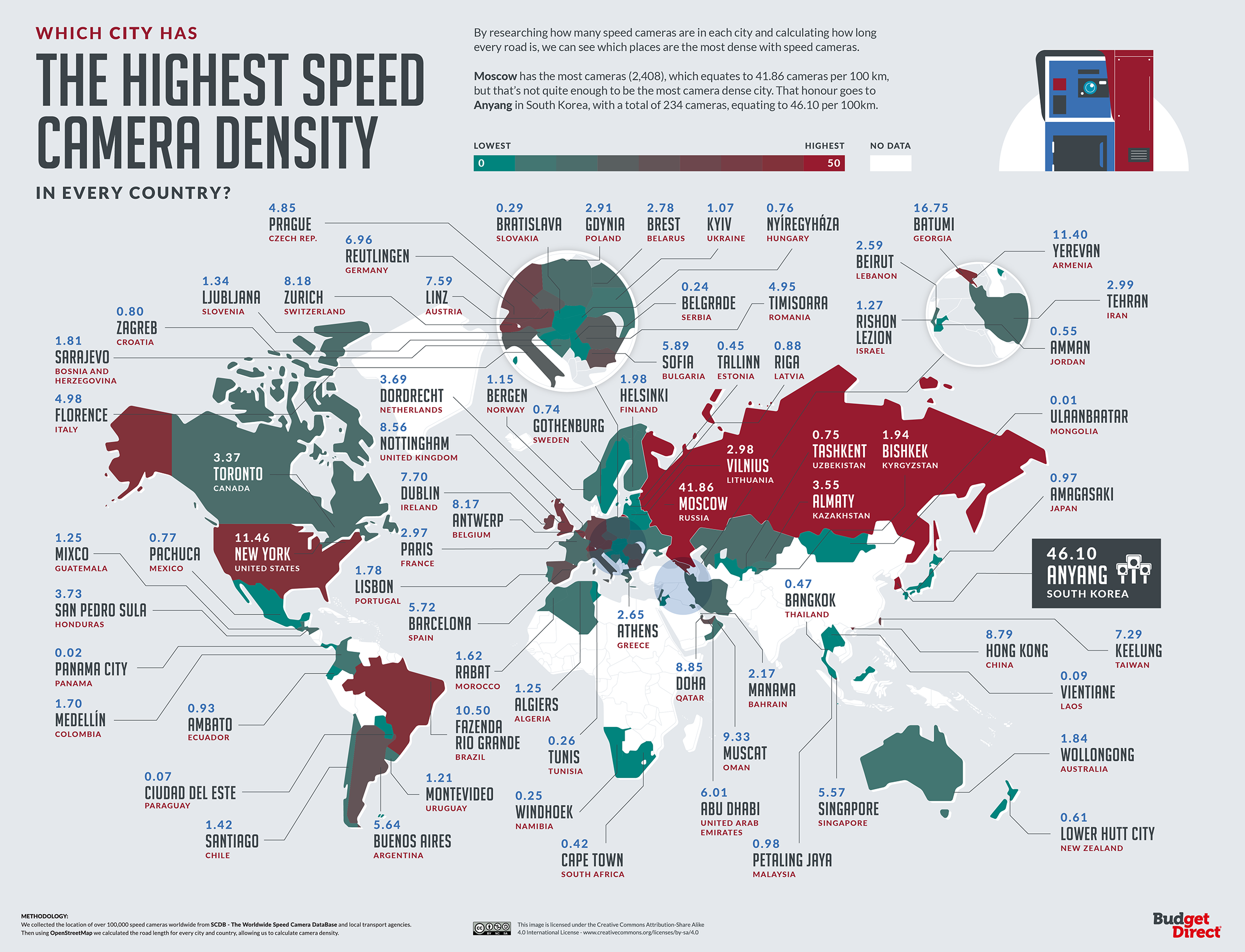
Anyang doesn’t have a lot of road, but the South Korean city has the eighth-highest number of cameras for any top national city in our study. That gives an average of 46.1 cameras for every 100km (or one camera every 2.17km) – the densest in the world. South Korea has an exemplary road safety profile, reducing annual child road death by 97% between 1992 and 2014. And Anyang is leading the way as a smart city with considerable high-tech infrastructure.
The only place with comparable density is Moscow (41.86/100km), another city where mass camera use is part of a move towards the smart city. After that, only four top cities have an average that reaches double figures. Fully 22 of the 73 countries for which data is available have fewer than 1 camera per 100km.
The Speed Camera Density of Almost Every Country on Earth
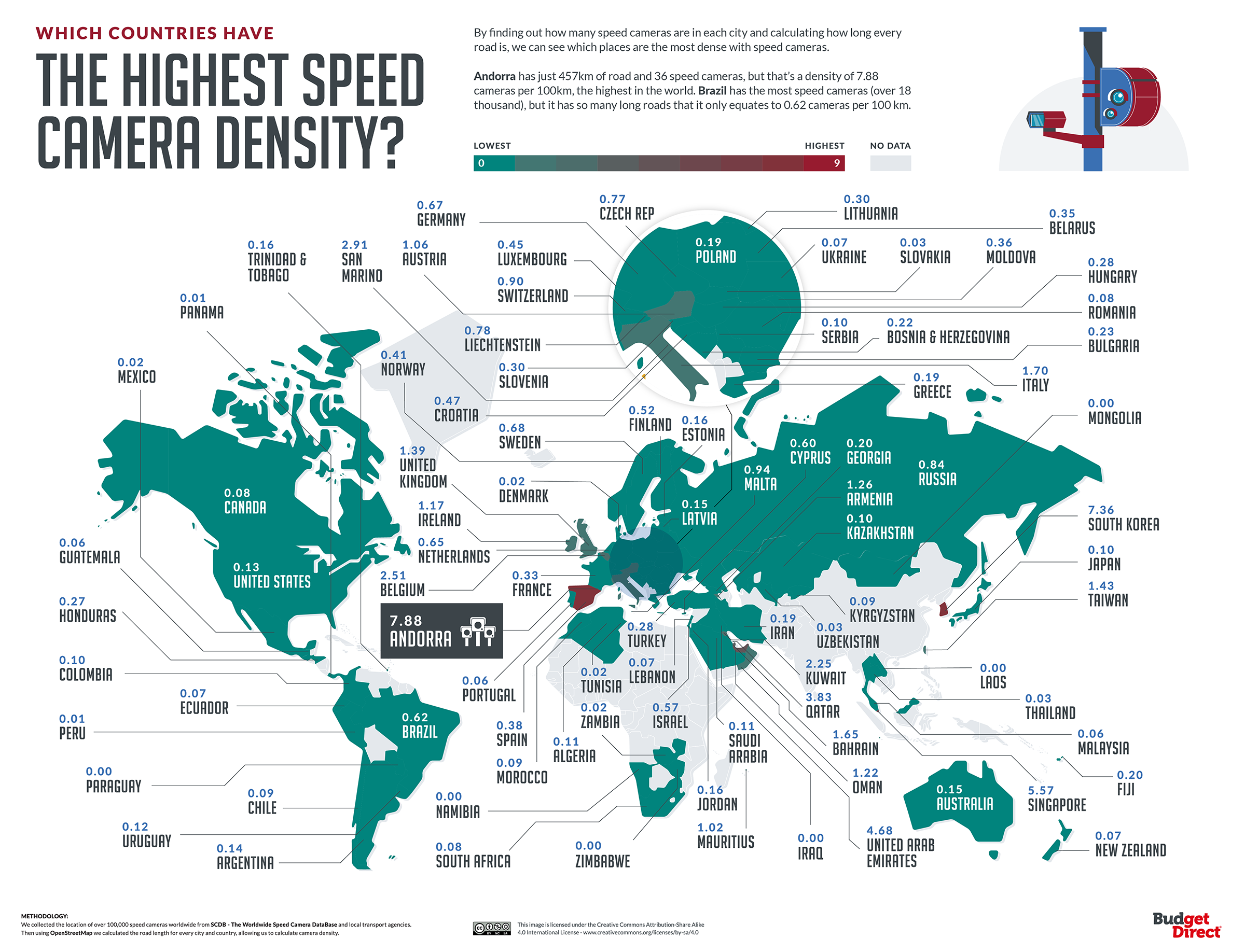
Next, we looked at the speed camera density averaged out across the whole of each country.
The small country of Andorra (77 thousand inhabitants) has just 457km of road and 36 speed cameras, but that’s a density of 7.88 cameras per 100km, the highest in our study.
Let’s take a closer look at the national results, continent by continent.
North America
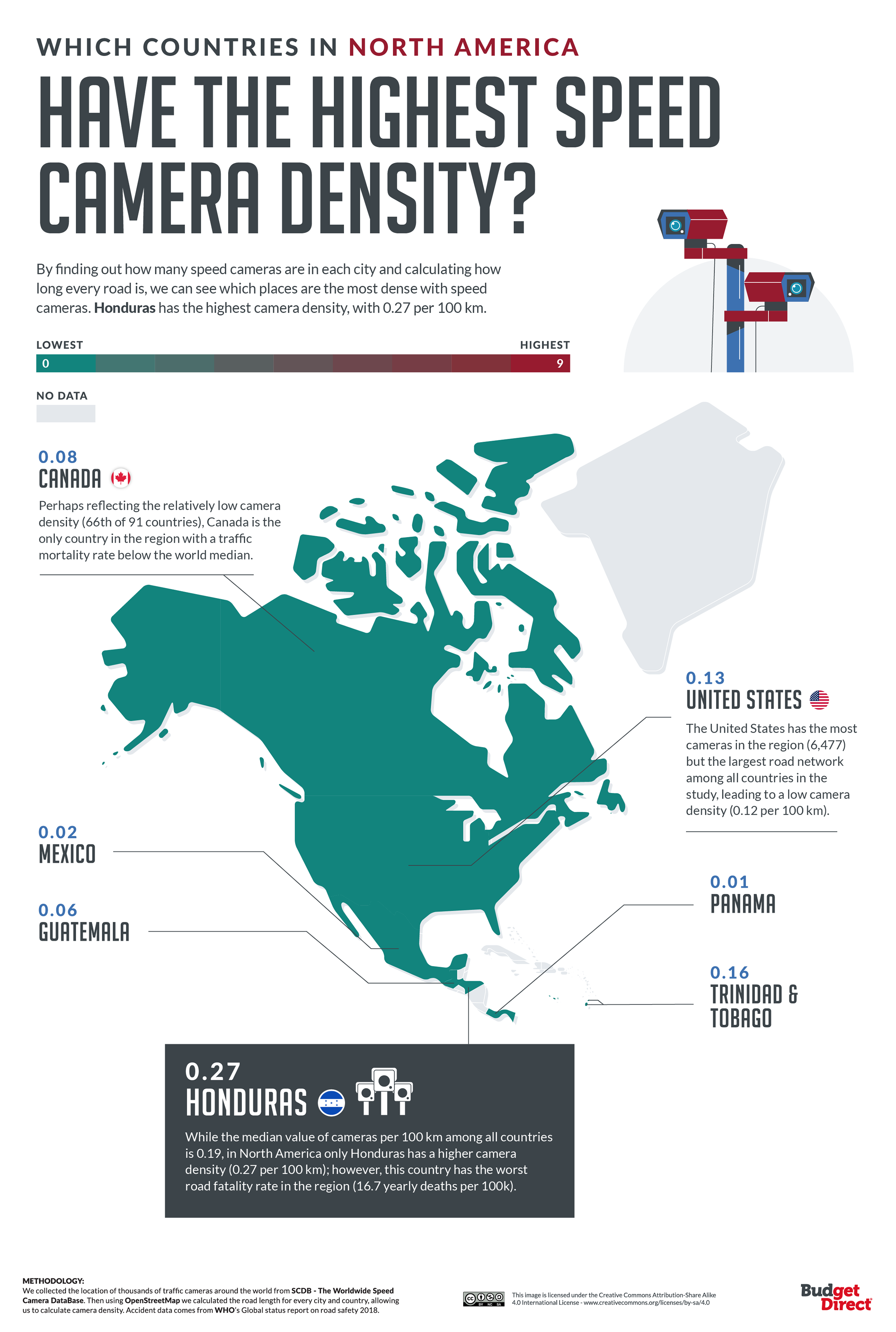
Road deaths in the US spiked by 24% during 2020. Around 42,060 people perished in motor vehicle crashes – the result of motorists racing down sparsely-used roads during lockdown. The US has the highest number of cameras for any country in North America – but it also has over 5 million kilometres of road, bringing the average down to just 0.13 cameras per 100km.
Honduras has the highest camera density in the region, but bucks the trend by also having the highest road fatality rate. However, vehicle safety regulations in Honduras are far below UN requirements, and this may explain why so many accidents end in death.
South America
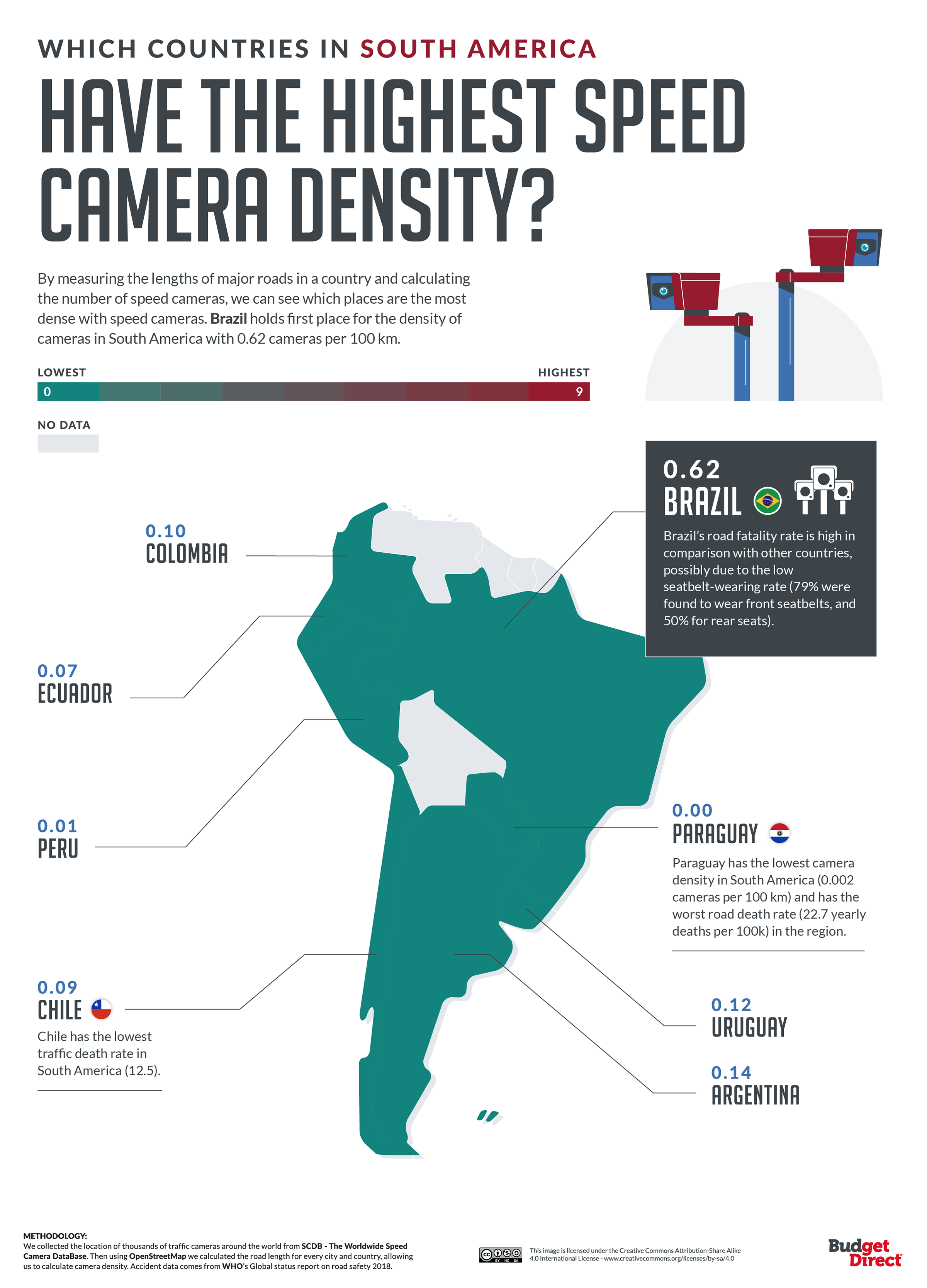
Brazil has the second-largest road network in our study (2.9 million km). Even so, Brazil has the highest density of cameras in South America (0.62), thanks to its 18,239 devices. And yet Brazil maintains a traffic death rate of 19.7 per 100,000 inhabitants per year – the fifteenth-highest in the world, and number three in South America. Low rates of seat belt wearing may be to blame.
Chile has the lowest traffic death rate in South America (12.5), but this is more than double the mortality rate in Canada despite the countries having similar camera density (0.087 vs. 0.084 cameras per 100km). Once more, seat belts make the difference: Chileans have a 14% seat belt-wearing rate in the back seat, compared to 89% in Canada.
Europe
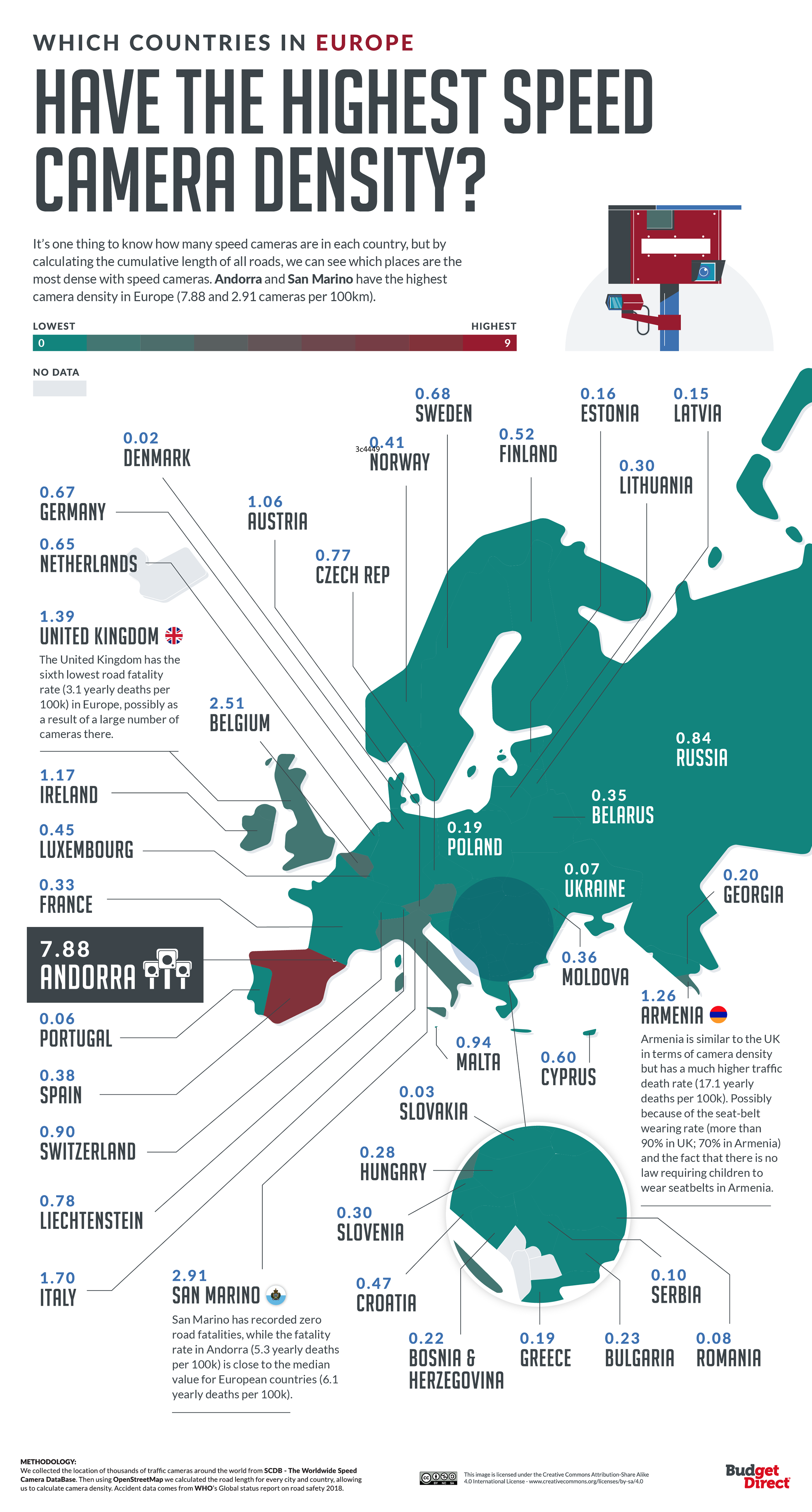
There are only 457 kilometres of road in Andorra, so it’s not too much of a stretch to have kitted them out with an average of 7.88 cameras per 100km – roughly one camera every 13km. Life expectancy is high in Andorra, but despite this and the high camera rate, the road death rate is 5.3 per 100,000 inhabitants per year – not far below the European average. Andorra is in a mountainous region, with winding and frequently snowy roads.
The UK has the fifth-highest camera density in Europe: 1.39 per 100km, spread across a 442,517 km road network. The traffic death rate in the UK is the sixth lowest (3.1) for Europe. There are more than a dozen types of speed camera in the UK, and a survey by the AA found that one in five Brits think it’s unacceptable to use cameras to identify speeding vehicles.
The Middle East & Central Asia
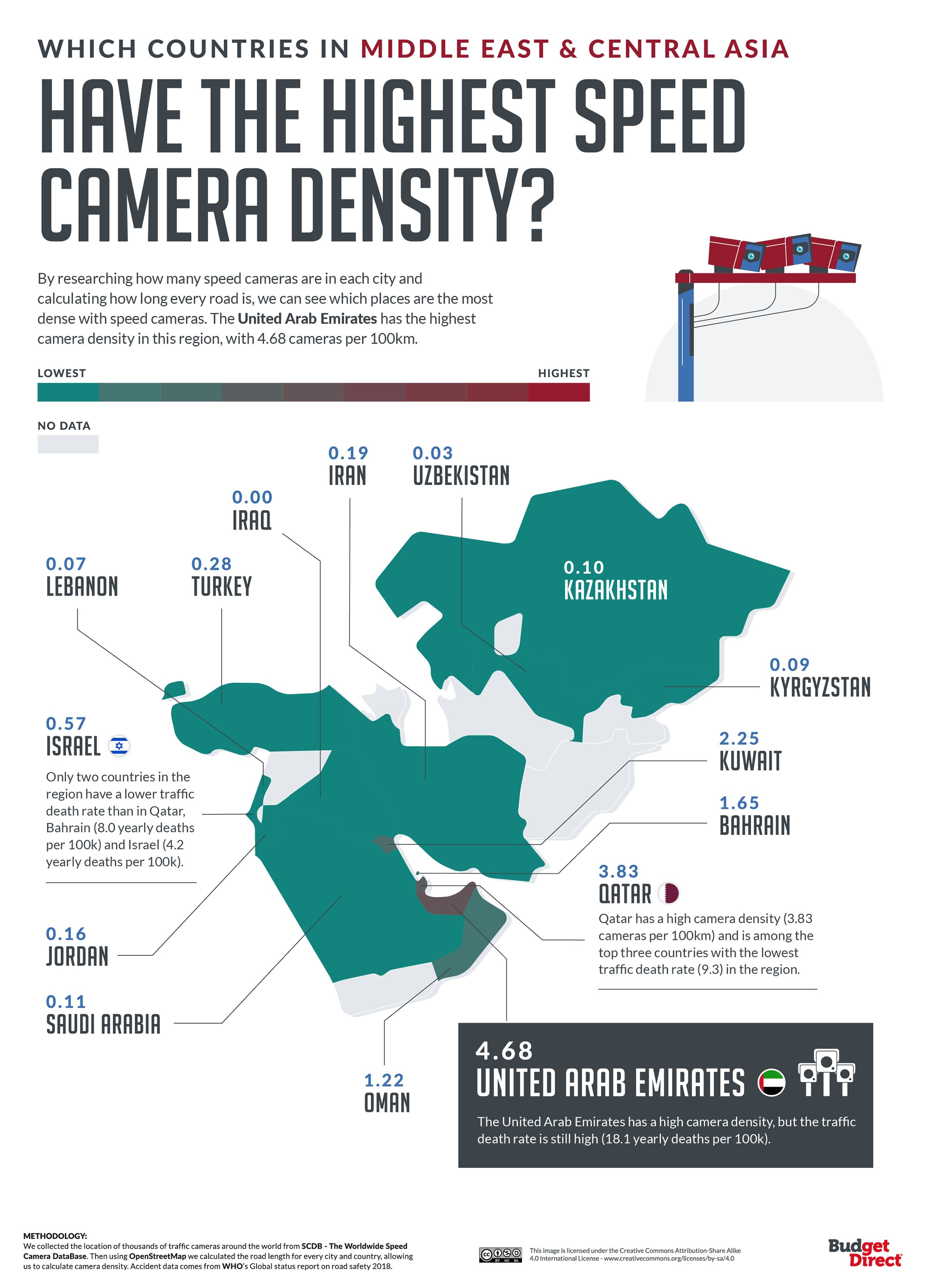
The United Arab Emirates has the highest camera density in the region (4.681 cameras per 100km). However, the traffic death rate remains high (18.1 deaths per 100,000 inhabitants per year), partly due to high distraction levels among drivers. Authorities are cracking down on certain driver activities – such as making live Instagram stories, using a selfie-stick, smoking shisha, and putting on make-up – in an effort to reduce the death rate.
The worst road death rate in the region is in Saudi Arabia (28 deaths per 100k population per year). The country has an average of just 0.11 cameras per 100km across its 301,150km road network.
Rest of Asia and Oceania
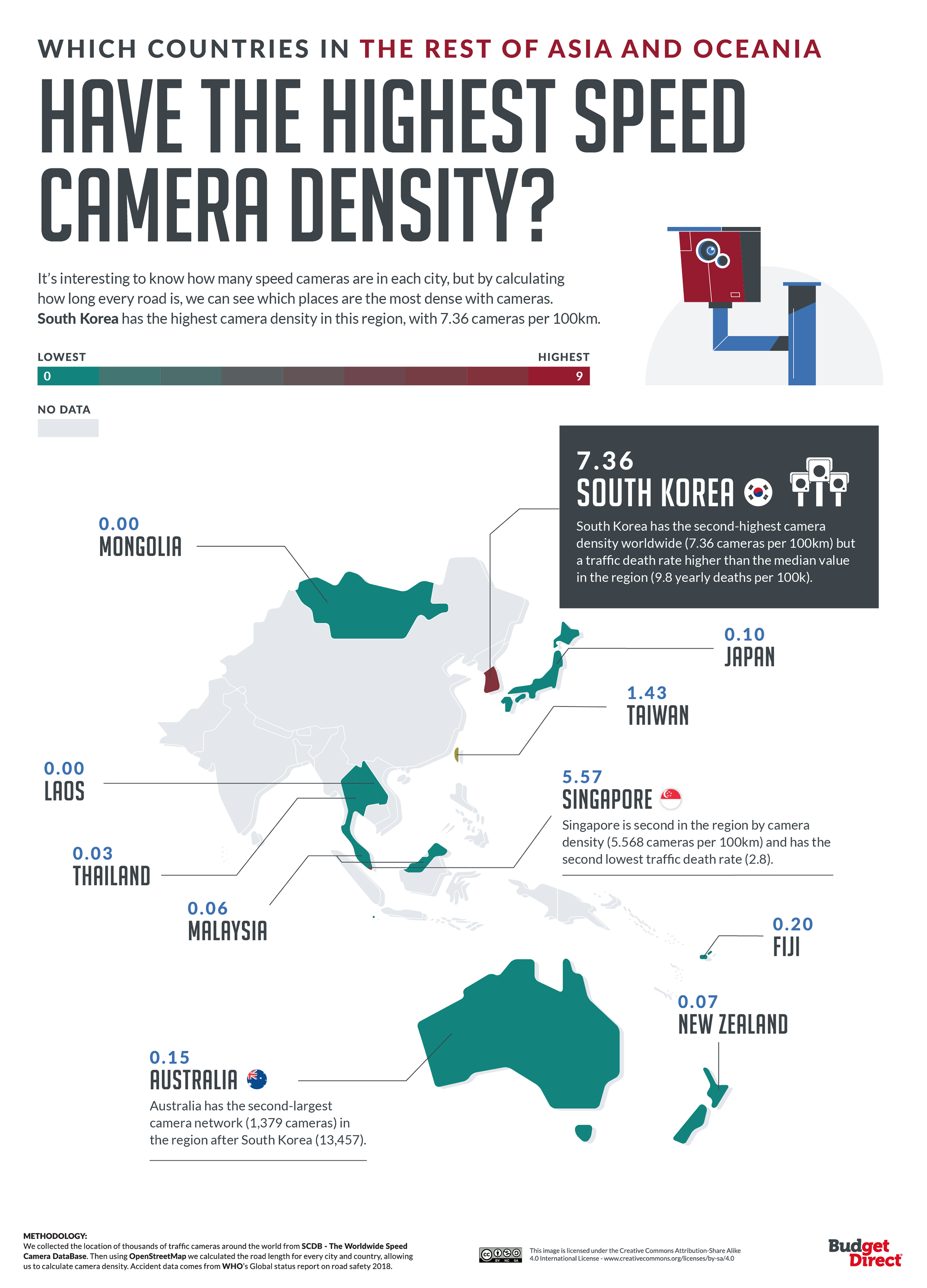
South Korea is the country with the world’s highest camera density, with 7.36 cameras per 100km. Sixteen out of the top 20 cities in our study are in South Korea – out of a total of 1,325 cities for which we have figures.
Australia has the second highest number of cameras (1,379) in the region, after South Korea (13,457). But the density of cameras in Australia is just 0.147 (#6 in the region). West Australia is to pilot a mobile point-to-point (average speed) camera set-up to counter the diluting effect of having so few cameras spread along such an extensive road network.
Africa
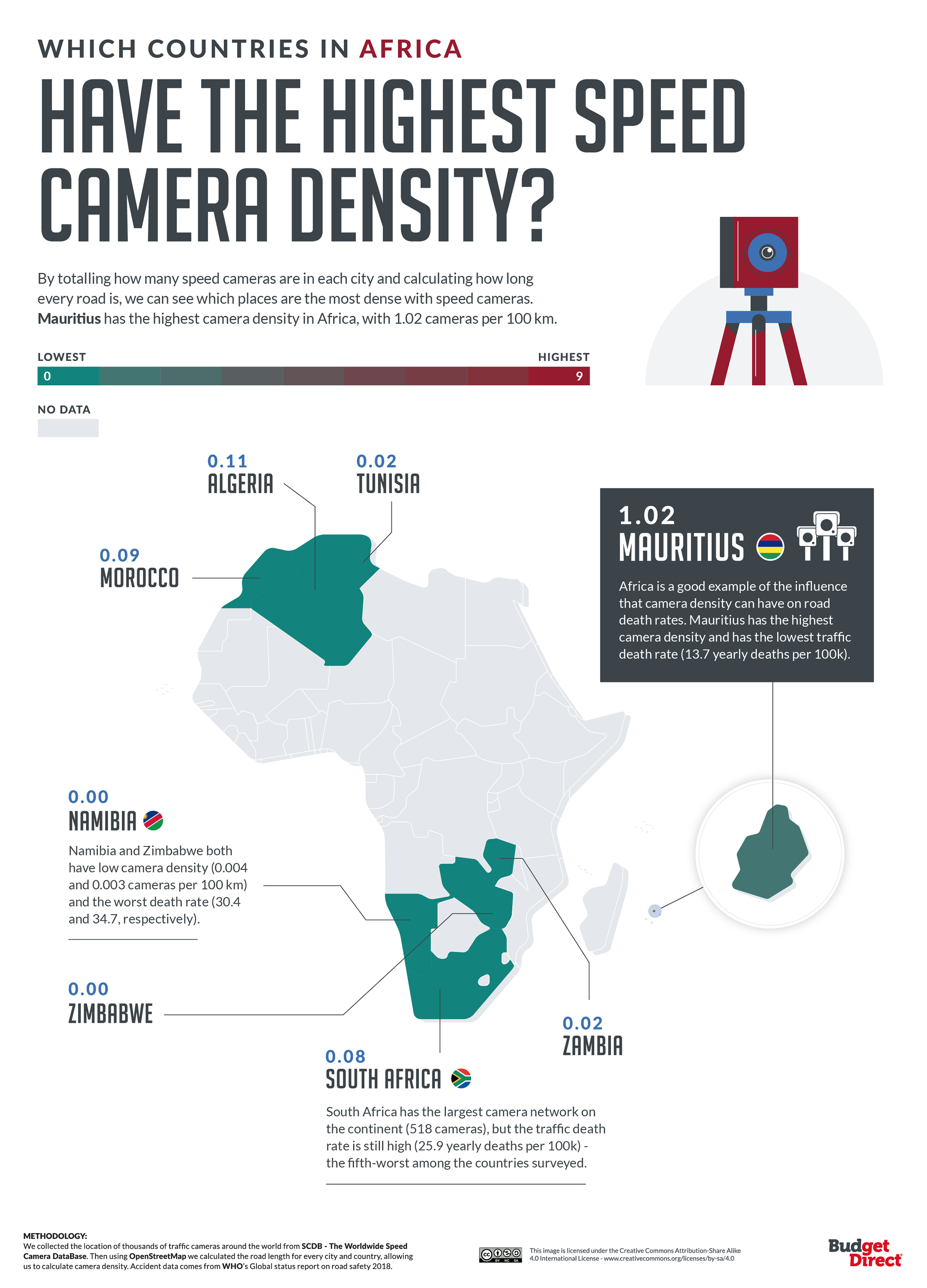
Africa is a good case study for seeing the effect of camera density on reducing road deaths. The country with the highest density, Mauritius (1.020 cameras per 100 km), has the lowest traffic death rate (13.7 deaths per 100,000 inhabitants per year). Meanwhile, the countries with the lowest density – Namibia (0.004) and Zimbabwe (0.003) – have the highest death rates (30.4 and 34.7).
South Africa has the largest camera network in the continent (518 cameras), but this is spread across the largest road network (664,212km), giving a low density of 0.08. The road mortality rate here is 25.9, the fifth highest in the world. In fact, six out of the 10 countries with the worst traffic death rate in our study are in Africa.
Which Australian Cities Have the Most Speed Cameras?
Australia’s 1,379 cameras are spread across a 937,978km network, so Australians can expect to encounter a camera every 680km or so… in theory. In practice, camera density depends very much on where in the country you are.
Wollongong gives you the safest ride, with a camera density of 1.84 per 100km across 1,518km of roads. This is some 61 times the density of Australia’s least camera-dense city – Gympie, Queensland, with a density of 0.03.
Find the Speed Camera Density in a City Near You
We sourced camera density and road mortality data on over 1,300 cities around the world for our study. To find out how many are near you, use our interactive table below. And remember, cameras aren’t there to be avoided, but to keep speed levels safe. Drive as if someone is always watching you!
Final Boarding Call
In many places in the United States, one can exceed the speed limit of a highway by five miles per hour with little concern — and in some places, exceeding the speed limit by ten miles per hour may be overlooked by law enforcement. Still, all you need is that one speed camera to catch you breaking the law by speeding.
I do remember seeing a lot os speed cameras when I drove across Andorra and back — and even worse is that technically, no limited access highway exists there, which causes some people to want to speed even more.
When a friend of mine who resided in France generously loaned me his personal car for the day so that I may visit Liechtenstein, he warned me not to exceed the speed limit on the highways in Switzerland — and I thankfully heeded his warning, as I understand that law enforcement in Switzerland is not very lenient to speeders, as the speed cameras in that country will photograph your vehicle even if you are exceeding a few kilometers beyond the speed limit…
…so if you plan on driving in a country other than your own, you should research their traffic laws so that you do not unknowingly commit an infraction.
Thankfully, no speed camera has ever caught me speeding; but have you ever been caught speeding by a speed camera? If so, please relate your experience in the Comments section below.
Photograph ©2017 by Brian Cohen.
